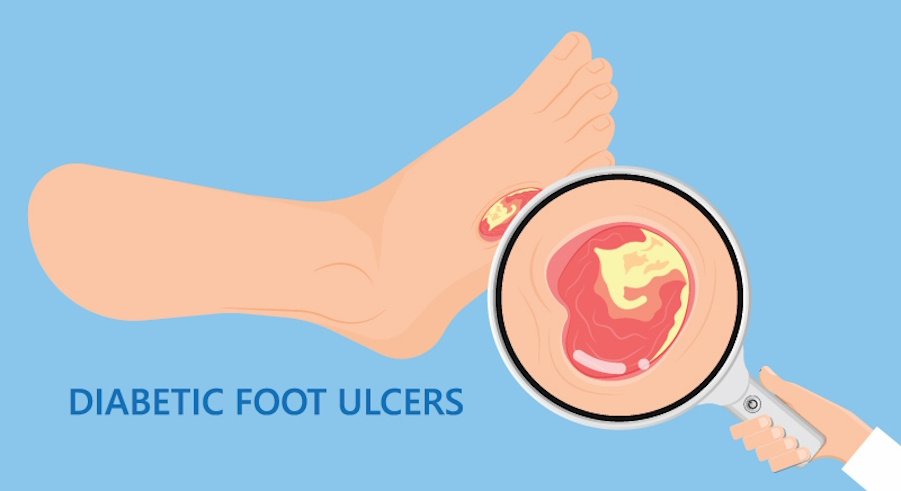American Diabetes Month: Who Is At Risk for Diabetic Vascular Disease?
Author: StrideCare Internal Team

Are you living with diabetes? If you are, then you’re already acutely aware of the many health challenges you might struggle with daily that other people don’t have to consider. This includes common issues such as excessive weight loss, fatigue, elevated blood sugar, having to go to the bathroom often, blurry vision, and increased hunger and thirst. But did you know many of the 100 million diagnosed diabetes patients worldwide are also at risk for diabetic vascular disease? In fact, elevated blood sugar alone can damage your blood vessels over time and cause a variety of changes in the appearance of your legs and feet. As a result, the likelihood of a stroke, heart attack, and non-healing wounds on your legs and feet increases exponentially.
At Stridecare Vascular, part of the StrideCare multispecialty network, we believe in promoting education and awareness efforts for our diabetic patients, especially as it relates to each patient’s ability to recognize vascular diseases. One item on that list is supporting American Diabetes Month each November. By keeping our patients educated, they can be more aware of when their body is telling them something is wrong—thus leading to faster intervention and treatment.
Do Any of These Diabetic Vascular Disease Symptoms Sound Familiar?
- Burning sensations in your toes and feet
- Leg pain, numbness, and weakness
- Pain that worsens with prolonged sitting or standing
- Heavy legs and painful cramping
- Swollen ankles, feet, and calves
- Foot and leg sores that are slow to heal
- Excessive itching
- Leg discoloration
- Coldness in the lower leg or foot
- No pulse or a weak pulse in the legs or feet
- Loss of leg hair

What Causes Diabetic Vascular Disease?
American Diabetes Month is an important time when communities across the country raise awareness for diabetes. What is diabetes? It is a disease where the body cannot produce or properly use insulin, a regulator of glucose in the blood. There are two main types of diabetes you could be diagnosed with:Type 1 Diabetes
Approximately 1.25 million Americans have Type 1. It is an autoimmune disorder that predominately affects children and adolescents, who need insulin injections to survive because the insulin-producing beta cells in their pancreas have been destroyed. Type 1 diabetes is usually hereditary.Type 2 Diabetes
While the pancreas produces insulin, it’s not producing near enough. This form of diabetes accounts for 90 to 95% of all diabetes cases, and its symptoms are more in line with possible diabetic vascular disease. The longer you have diabetes, the higher your risk of developing diabetic vascular disease. This is because diabetes creates blockages within your vascular system that obstruct circulation. When diabetic vascular disease affects your feet, and you lose feeling, you may not even realize you have a foot sore or an infection. Left untreated, these problems can lead to tissue death and possible amputation of the affected toes or foot.
Vascular Conditions Common in Diabetic Patients
Below is a breakdown of a few vascular diseases that could present themselves in diabetic patients:
Peripheral Arterial Disease
Also known as arteriosclerosis, PAD is a condition where plaque build-up on the walls of blood vessels causes them to narrow and leads to poor blood circulation. When this happens, not only does a person experience the symptoms above, but they are at risk for coronary artery disease, heart attacks, or strokes. While PAD symptoms vary widely, up to 4 in 10 people don’t even have symptoms at first.
Chronic Venous Insufficiency
With venous insufficiency, one or more veins fail to return blood efficiently to the heart. As this condition worsens, chronic venous insufficiency (CVI) develops with broken valves in the legs that don’t hold a seal. As a result, blood pressure builds up and leads to pooling of blood, swelling, and skin changes.
Restless Leg Syndrome
Approximately 1 in 10 adults suffer from Restless Leg Syndrome (RLS), which is classified as a sleep disorder since it is best known for rearing its ugly head while a person is at rest—especially when sitting or lying down. Restless Leg Syndrome can feel like pins and needles or itchiness and only improves or is eliminated completely with movement.
Critical Limb Ischemia
Critical limb ischemia drastically reduces blood flow to the lower body and lower extremities, causing various leg pain symptoms that won’t go away and open sores and ulcers. Patients who have critical limb ischemia typically have diabetes or have a history of having high cholesterol.
Deep Vein Thrombosis
These life-threatening blood clots form in the deep, large veins of the pelvis, legs, thighs, or arms and reduce or block the flow of blood in a vein. One common complication of DVT is known as post-thrombotic syndrome. People with this syndrome may have a swollen leg that feels heavy and hurts. More severe cases of post-thrombotic syndrome can lead to the formation of chronic wounds.
What Are My Treatment Options for Diabetic Vascular Disease?
At Stridecare, we tailor your comprehensive treatment plan to your individual health needs for a whole-person approach to helping you manage your diabetic vascular disease. Treatment may include taking steps to get your diabetes under control, such as losing weight, exercising more, and eating healthier foods. Our vascular physicians may also prescribe medications to lower your cholesterol and blood pressure. Other options include elevating your legs while resting, avoiding smoking, wearing compression socks, drinking more water, and properly managing blood sugar levels at all times.
Beyond these conservative treatment measures, our experts may recommend minimally invasive surgical procedures to help restore circulation to your legs and feet. This can include angioplasty, stent placement, or atherectomy.
It’s extremely important not to ignore the symptoms of diabetic vascular disease. If you have foot pain, swelling, or sores that won’t heal, don’t wait to seek medical intervention.
Stridecare Can Help with Diabetic Vascular Disease
Far too many people genuinely believe they are stuck with the health challenges that come with diabetes. But life doesn’t have to be this way. While diabetic patients are more at risk for diabetic vascular disease, the condition and its symptoms can be managed effectively with the right treatment approach and a compassionate team of vascular experts in your corner at all times. Our expert doctors and highly skilled team members at Stridecare, part of the StrideCare multispecialty network, are proud to offer treatment for a variety of vein and artery diseases to dramatically impact your quality of life. We only utilize the latest technologies and minimally invasive procedures. Procedures take place at in-office or outpatient settings. Patients suffering from a multitude of vascular conditions that include venous insufficiency, varicose veins, spider veins, diabetic vascular disease, venous ulcers, peripheral artery disease, leg discoloration, lymphedema, restless legs syndrome, and more can benefit from these minimally invasive treatments. If you have questions on treating your leg veins, the experts at Stridecare will recommend an individualized plan to help you get the best results. For a consultation with one of our specialists, please contact us at 214-382-3200 or complete the appointment form.Prior to starting any new treatment or questions regarding a medical condition, always seek the advice of your doctor or other qualified health provider. This information is not a substitute for professional medical advice.
Stridecare serves the D/FW area including Dallas, Mesquite, Craig Ranch, Sherman, Dennison, Arlington, Fort Worth, Southlake, South Dallas, North Dallas, Addison, Carrollton, Richardson, Garland, Highland Park, University Park, Park Cities, Plano, Frisco, Allen, McKinney, Irving, Grand Prairie, Denton, Lewisville, Flower Mound, HEB, Hutchins, Duncanville, DeSoto, Cedar Hill, Lancaster, Cockrell Hill, and all North Texas.
*Patient stories are true. Names and/or photos may be changed to protect patient confidentiality.


